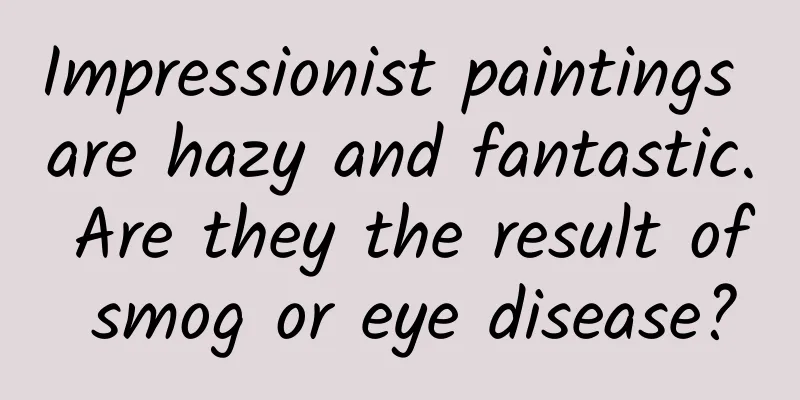Impressionist paintings are hazy and fantastic. Are they the result of smog or eye disease?

|
In many people's impressions, the paintings of Impressionist master Oscar Monet are like "smog", especially his late works, which are all hazy and blurred landscapes. But in fact, his early works (such as "Woman in Green") are also very clear and have smooth lines. Why did Monet's painting style suddenly change? Was it the painter's own inspiration, or was it caused by eye disease, or was there another reason? Today, let's talk about the science in art and reveal where the hazy fantasy of Impressionist style came from. There are actually quite a few interesting studies on the Impressionist style. Just recently, Anna Lie Albright of the Sorbonne University in Paris and Peter Huibers of Harvard University studied the formation of the Impressionist style, and the relevant paper was published in the Proceedings of the National Academy of Sciences on January 31, 2023. The two scholars believe that the Impressionist style is closely related to the bad air in Europe at the time, which makes the Impressionist style hazy and magical. Before talking about the relationship between the Impressionist style and air pollution, let's talk about what Impressionist painting is. Impressionist painting is a type of painting that expresses visual experience, focusing on color and light. Unlike classical painting, the perfection of line and form is hardly reflected in Impressionism. (Monet's Impression, Sunset, 1872) Impressionist painting is just as its name suggests. The painting style is like a moment captured by the human eye in an out-of-focus state. There are no details, but it can make people feel the vitality of the picture. Monet, an artist who lived in the 19th century, was called the "poet of light" for his unique painting style. His work "Impression, Sunrise" depicts the changing state of light and color at sunrise over the harbor. But is this hazy feeling inspired by the artist's creation, or did he truly reproduce the natural environment at that time? Perhaps only bad air pollution can produce such a scene. (Compare) Monet's "Women in the Garden of Sainte-Adèle," created in 1867. Monet's "The Parliament with the Seagull", 1903. As the researchers hypothesized. In the 19th century, Europe was in the midst of the Industrial Revolution. At that time, Western European countries were affected by the Industrial Revolution. Heavy industries such as coal, metallurgy, and chemistry developed rapidly, and the emission of air pollution also increased dramatically to an unprecedented level. For example, Britain, which was the first to complete the Industrial Revolution, emitted almost half of the world's total sulfur dioxide emissions from 1800 to 1850. London, which accounts for only 1% of the UK's area, has sulfur dioxide emissions close to 10% of the UK, or 5% of the world's total. With such serious air pollution, air pollutants such as soot particles will affect the visibility of the air, reduce the contrast of natural light and increase its intensity. The aerosol system composed of pollutants will cause visual obstruction and form haze. Therefore, Britain in the 19th century was known as the "City of Fog". This environmental feature has certain similarities with the blurred and hazy style of Impressionist paintings. (Air pollution in Europe in the 19th century) To further explore the relationship between the Impressionist style of painting and air pollution, the researchers systematically examined paintings by Monet and his predecessor, Joseph Mallord William Turner. Turner’s work was primarily about Britain, while Monet’s paintings were primarily about Paris and London, both cities with a history of high coal emissions. Sulfur dioxide (SO2) emissions in London and Paris in the 19th century (London, England, 19th century) The researchers compared 60 paintings by Turner and 38 paintings by Monet with the sulfur dioxide emission index in London or Paris that year, and found that Turner's painting style had changed significantly: the outline changed from sharp to blurred, the color changed from strong to light, and the image became more impressionistic. This is consistent with the trend of increasing air pollution at the time, and the same situation happened to Monet. Ultimately, they concluded that the Impressionists' paintings truly depicted the changes in light conditions during the Industrial Revolution, when there was air pollution. Air pollution is inextricably linked to their painting style. Turner's "Apulia in Search of Aprilis", exhibited in 1814, and Turner's "Rain, Steam and Speed - The Great Western Railway", painted in 1844. So, how does air pollution cause light changes and thus affect our vision? For example, in this painting by Monet, the light reflected from the building should normally be represented by the black arrow, and there is also light in the background around it. But when the air is filled with a lot of aerosols, the background light will be scattered into our field of vision, blurring the originally very obvious edge of the tall building, and the whole picture will be whiter and brighter. Therefore, the hazy artistic style of Impressionism is also a reflection of the bad air environment at that time. Of course, in addition to the impact of air pollution and light environment, there is also a saying that the Impressionist style is also related to Monet's eye disease. In 1912, Monet suffered from cataracts. At this time, Monet was already in his old age. When painting, he had to get very close to see the objects, so his works in his later years were also magical. Eye diseases do have an impact on painting style. The master painter Edgar Degas once became manic due to his declining eyesight. He began to paint with a blurrier palette, and his style in his later years tended towards Impressionism. It’s worth noting that Monet was already an Impressionist before he developed cataracts, so air pollution may have influenced his style more than his eye disease. Through the paintings of the Impressionists, we understand the changes in the atmosphere in the 19th century. Therefore, many people believe that the Impressionists themselves reflect realism and they "faithfully" record the natural phenomena of the time. This statement certainly does not reduce the artistic value of the Impressionists. On the contrary, through their paintings, we can get a glimpse of the environmental pollution at that time. This article is a work supported by Science Popularization China Starry Sky Project Team Name: Deep Science Reviewer: Chen Xiaolong Produced by: China Association for Science and Technology Department of Science Popularization Producer: China Science and Technology Press Co., Ltd., Beijing Zhongke Xinghe Culture Media Co., Ltd. |
>>: Wild giant pandas spotted in Qinghai? Experts: Impossible
Recommend
Community operation methodology: how to gather target users
In early 2015, communities began to become popula...
Complete online event operation process!
Online activities must be able to produce short-t...
Practical course on sharing good products through short videos: quick account creation and upgraded anti-transfer editing
Practical course on sharing good products with sh...
The room-temperature superconductivity paper published in Nature set off a physics explosion! Is the spring of superconducting applications really coming soon?
The road to finding superconducting materials sui...
There is no real hangover cure in the world, and you can’t train yourself to be able to drink more!
The Spring Festival is undoubtedly the most impor...
Talk about the three methods of gaining users through paid social networks
In recent years, various paid communities are sti...
In-depth analysis of why Android apps are of low quality and crash
Unlike the situation a few years ago when iOS was...
Is the new euthanasia capsule truly painless?
Death is a long and painful process for most peop...
These 7 points will help your landing page conversion rate soar!
A landing page , also known as a "landing pa...
3 Steps to User Growth Strategy
User growth strategies need to be changed accordi...
2019 Tik Tok promotion and operation strategy!
20% of the videos account for 80% of the views, b...
1 in 4 adults has high blood lipids! Stay away from these 4 high-risk factors →
When it comes to high blood lipids, even young pe...
World Health Day: Can’t give up the taste? “Sodium” is not a good idea! If you like strong flavors, you should reduce the amount of salt!
What are the difficulties in reducing salt intake...
Former PM Director of NetEase: Design experience in mobile Internet product login, registration, new user guidance, and layout
Introduction: Guo Ziwei, former director of NetEa...
How to choose Tik Tok shooting tools and editing software?
1. It is recommended to use a mobile phone for sh...









